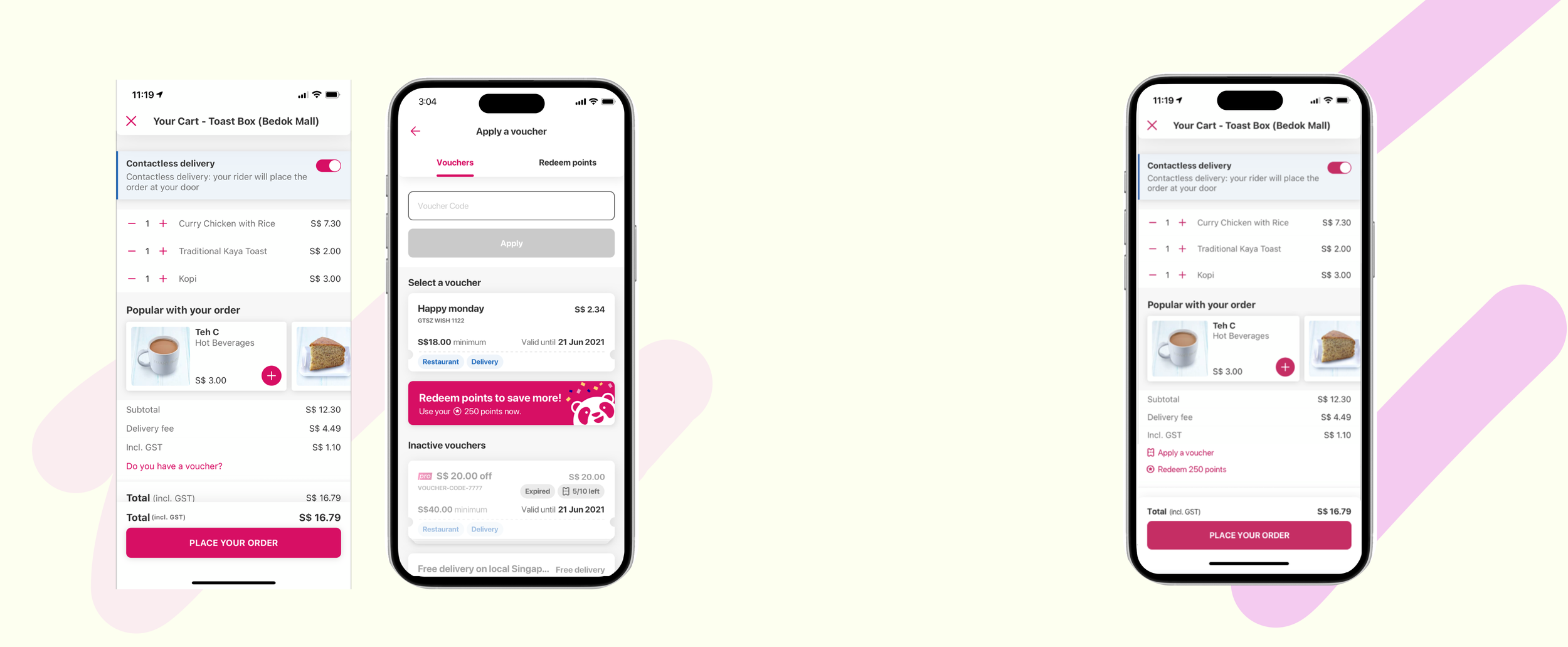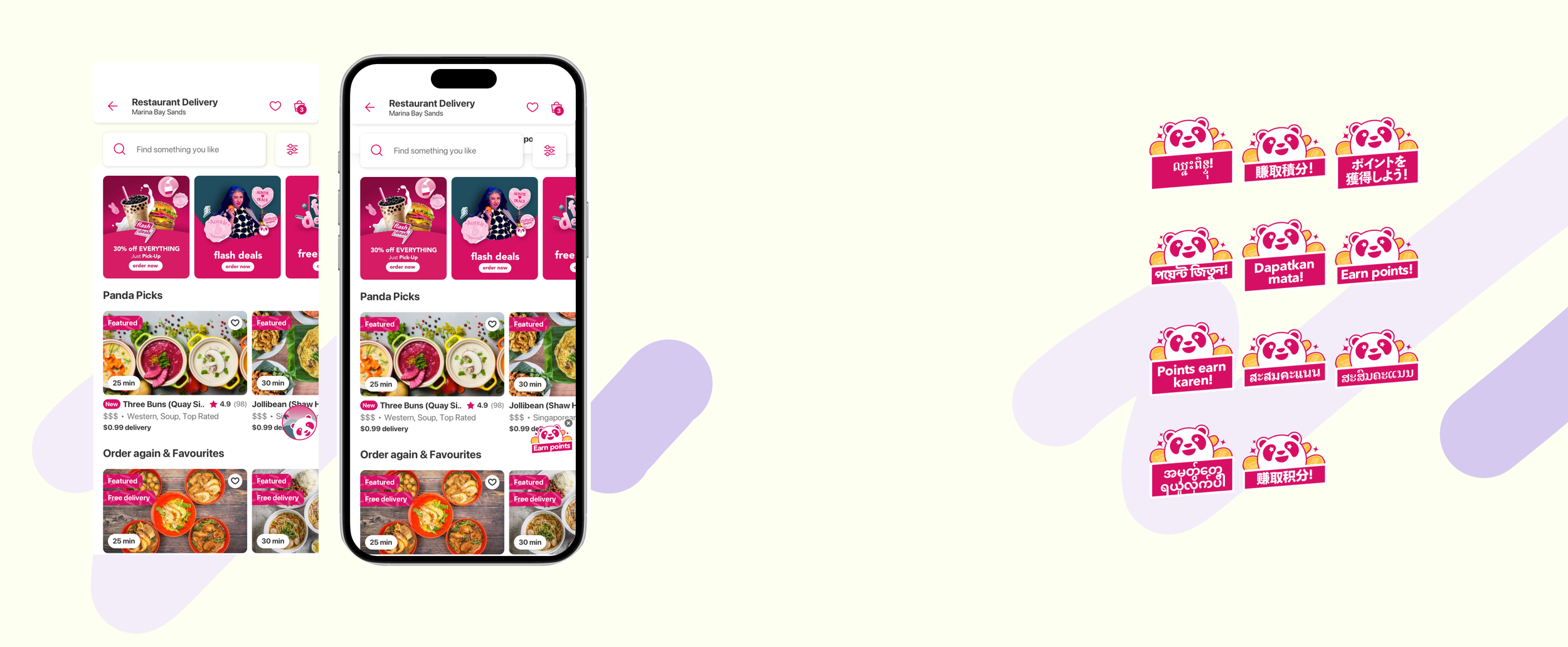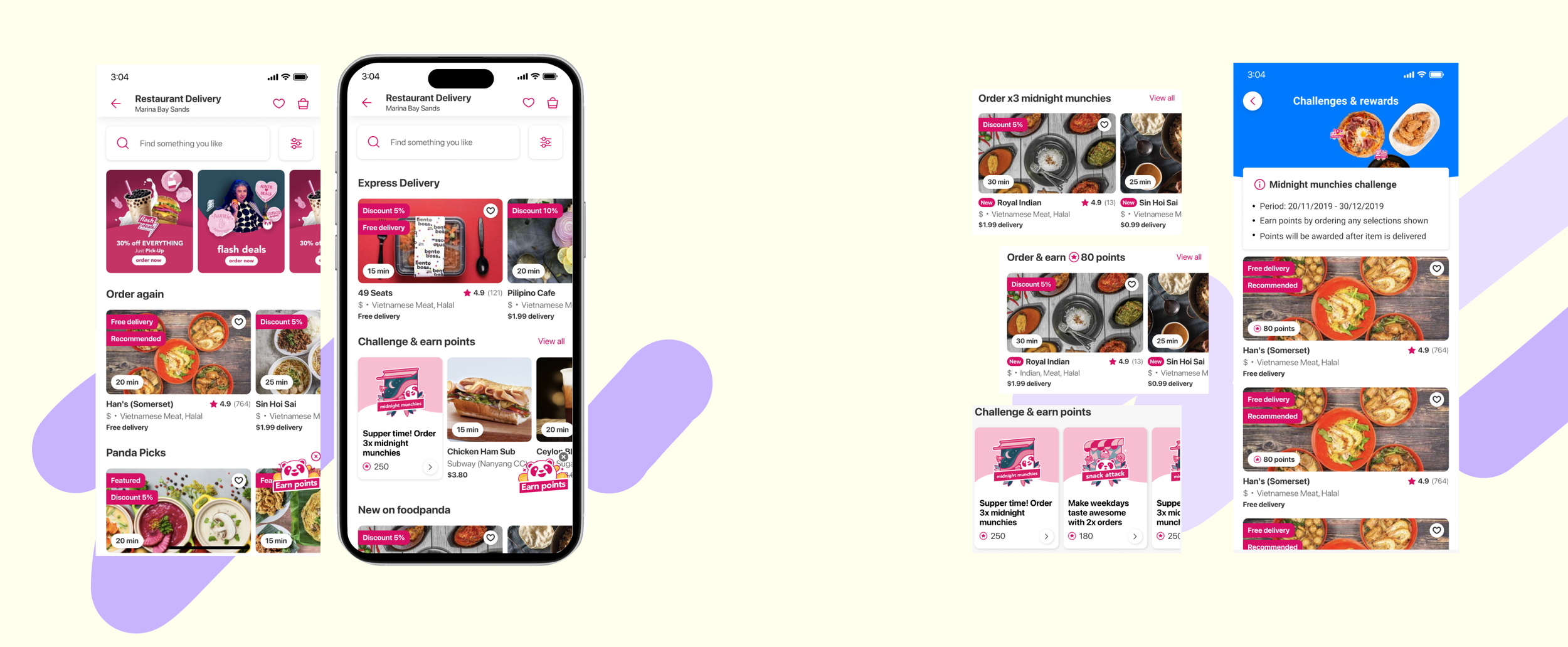Designing for Delight at Foodpanda
Crafting engaging and rewarding experiences for millions of users on one of Asia's leading food delivery platforms.
Key Challenges
Designing for a global platform like Foodpanda presented a unique set of challenges. A key task was balancing the diverse needs and cultural nuances of a massive user base across many different countries with the need to maintain a consistent and scalable product. It also required careful alignment with a wide range of stakeholders—from local marketing teams to central tech leadership—each with their own priorities. Navigating this complex landscape while working in an agile, fast-paced environment demanded constant communication, adaptability, and a relentless focus on the core user problems we were trying to solve.
How I Design
Within the Loyalty squad, my work was guided by a few core principles.
Clarity and Simplicity: I believe that even complex gamified systems should feel intuitive and effortless to the user.
Create Delight: Beyond pure functionality, I aimed to inject moments of joy and positive surprise into the experience to make it more memorable and engaging.
Meaningful Motivation: It was crucial that our loyalty features were not just manipulative, but provided genuine value and a sense of accomplishment for the user.
Build Trust: Every interaction, especially those involving rewards and progress, had to be transparent and reliable to build long-term user trust and loyalty.
Why I Design at Foodpanda
My journey to Foodpanda was a deliberate transition from the fast-paced world of a B2B cybersecurity startup, Horangi. While I valued my experience there, I was driven by a desire to understand design at a massive scale. I wanted to immerse myself in a corporate environment to learn how a globally recognized app with millions of users operates. My goal was to observe and contribute to the complex processes, cross-functional collaboration, and strategic thinking required to build and maintain a product that impacts so many people's daily lives. With the food delivery industry at its peak during the pandemic, it felt incredibly meaningful to contribute to a service that was so essential, playing a part in bringing food safely to people when they needed it most.
I am part of the loyalty & gamification squad, working on customer facing products like points and gamification experiences, as well as internal Marketing Management Tool to make challenges and rewards visible to customers. I worked in foodpanda across 13 markets in APAC and EU (foodpanda, NetPincer, Damejidlio). I collaborate with counterparts in Berlin (Delivery Hero), as well as UX researchers, product specialists and product analysts.
As a Product Designer at Foodpanda, I had the exciting challenge of shaping the user experience for one of the leading food and grocery delivery platforms in Asia. My role was deeply embedded in a fast-paced, collaborative environment, where I worked alongside product managers, engineers, and researchers to solve complex problems for millions of users.
About Foodpanda
Foodpanda is a global online food and grocery delivery platform, operating in over 40 countries across Asia, Europe, and the Middle East. As a subsidiary of Delivery Hero, its mission is to deliver good food to people's everyday lives, offering a vast selection of restaurants, shops, and groceries through a convenient and user-friendly mobile app.
Foodpanda (stylized in lowercase as foodpanda) is an online food and grocery delivery platform brand owned by Delivery Hero, which is headquartered in Berlin, Germany and operates with 20 brands in about 50 countries across four continents. The Foodpanda brand, currently used in Asia, Bulgaria, and Romania, was acquired by Delivery Hero in December 2016.
When I first joined foodpanda as a product designer, I was intrigued by the number of designers working separately and together on projects in Singapore and Berlin. Before the pandemic, there was already a gap of time differences to bridge between the Singapore and Berlin team, so over-communication was invariable for success.
My Objective
My primary objective at Foodpanda was to transform the functional, everyday act of ordering food into a more engaging, rewarding, and memorable experience. I aimed to drive user loyalty and increase retention by designing features that not only met user needs but also created moments of delight and connection.
Within the Loyalty & Gamification squad, this required a focus on user-centric design and recognizing that our work was strongly tied with marketing. Therefore, I worked in close partnership with the branding and marketing teams to ensure our design solutions created synergy and amplified the desired outcomes for our campaigns and for the brand as a whole, making Foodpanda not just a utility, but a brand that users genuinely enjoy interacting with and feel valued by.
Loyalty and Gamification
Loyalty and gamification is about transforming the standard customer experience into something more interactive and rewarding. At Foodpanda, this meant moving beyond simple transactional relationships. We used game-like mechanics such as points, badges, challenges, and leaderboards to create a sense of progress and achievement for our users. The core idea was to make ordering food not just a task, but an enjoyable journey where users feel valued and are motivated to return, ultimately building a stronger, more lasting connection with the brand.
Better Experience, Better Engagement
Then, what do people think about reward program using gamification? We ran a campaign (in MY, TH, HK, PH, BD, TW and CA) to determine if a reward program using gamification would be successful in increasing retention and order frequency. The results were:
A reward program (within reasonable cost) can increase order frequency and retention.
User engagement to a Loyalty gamification product is positive when the appropriate segment is targeted (i.e.: active frequent, active steady, loyal or neither).
As we constantly reflect and improve our vision and goals, the ultimate one is to create engagement by gamifying actions and rewarding users with incentives to promote loyalty.
Team Dynamics
In our squad, it consist of a product manager, 2 engineers each for iOS, Android and Web. Being the product designer of the team, I usually start with rough lofi-wireframes with the workflow, so that it can be concurrent for our BE engineers to figure the engineering efforts behind. Depending on the type of features, considering the efforts for each device, I will have syncs with the different teams on individually.
How we prioritise projects
Every quarter, each squad has to come out with a plan for each quarter, on main features as well as feature enhancements. As a designer, I would request a list of features that are critical for user experience, measuring it with impact, confidence and effort (ICE).
My Role in the Loyalty & Gamification Squad
I was a core member of the Loyalty & Gamification squad, a specialized team focused on driving user engagement and retention. Our goal was to make the Foodpanda experience more rewarding and enjoyable. We designed and implemented features like loyalty programs, challenges, and rewards that encouraged repeat orders and fostered a stronger connection between the user and the brand. This involved a deep dive into user psychology and motivation to create compelling experiences that kept users coming back.
In Loyalty Squad, I shipped a total of:





